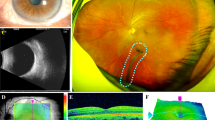Abstract
AA is a 3-month-old baby who was noted by the pediatrician to have a white reflex in the right pupil. He was referred to a pediatric ophthalmologist who performed an examination under anesthesia. Echography was performed as part of this exam which revealed some thickening at the nasal iris root. A specific mass was not seen, but a tumor could not be ruled out. The EUA was repeated with some increase in thickness of the lesion. This continued over the next 2 months, and the lesion was noted to be growing across the back of the lens by immersion ultrasound (Fig. 1). The pediatric ophthalmologist was concerned enough about the possibility of a diktyoma (medulloepithelioma) to do a needle biopsy, but the cytology was nonspecific. He had discussed the possibility of enucleation with the parents and proceeded with this procedure. However, pathology was consistent with persistent hyperplastic primary vitreous (PHPV), and no malignancy was identified.
You have full access to this open access chapter, Download chapter PDF
Similar content being viewed by others
Keywords
These keywords were added by machine and not by the authors. This process is experimental and the keywords may be updated as the learning algorithm improves.
AA is a 3-month-old baby who was noted by the pediatrician to have a white reflex in the right pupil. He was referred to a pediatric ophthalmologist who performed an examination under anesthesia. Echography was performed as part of this exam which revealed some thickening at the nasal iris root. A specific mass was not seen, but a tumor could not be ruled out. The EUA was repeated with some increase in thickness of the lesion. This continued over the next 2 months, and the lesion was noted to be growing across the back of the lens by immersion ultrasound (Fig. 1). The pediatric ophthalmologist was concerned enough about the possibility of a diktyoma (medulloepithelioma) to do a needle biopsy, but the cytology was nonspecific. He had discussed the possibility of enucleation with the parents and proceeded with this procedure. However, pathology was consistent with persistent hyperplastic primary vitreous (PHPV), and no malignancy was identified.
Coat’s disease is another condition that is sometimes mistaken for an intraocular malignancy. This is usually a unilateral condition found in males two thirds of the time in the 8-month to 18-year-old age group. It is the result of excessive permeability of retinal capillaries causing subretinal lipid exudation. Echography often demonstrates a convection-like movement of cholesterol deposits under the retina. The various pathological entities resulting in leukocoria can be subtle and be missed on gross examination by the non-ophthalmologist. Mothers often have an innate sense of when something is wrong with their child’s eye, and the pediatrician is advised to take her concerns very seriously.
Author information
Authors and Affiliations
Rights and permissions
Copyright information
© 2014 Springer Science+Business Media New York
About this chapter
Cite this chapter
Harrie, R.P., Kendall, C.J. (2014). Case Study 178 PHPV Misdiagnosed as a Diktyoma. In: Clinical Ophthalmic Echography. Springer, New York, NY. https://doi.org/10.1007/978-1-4614-7082-3_178
Download citation
DOI: https://doi.org/10.1007/978-1-4614-7082-3_178
Published:
Publisher Name: Springer, New York, NY
Print ISBN: 978-1-4614-7081-6
Online ISBN: 978-1-4614-7082-3
eBook Packages: MedicineMedicine (R0)





